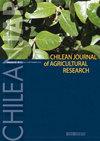钾肥对红姜产量、养分利用和响应效率及抗氧化物质含量的影响
IF 1.7
4区 农林科学
Q2 Agricultural and Biological Sciences
引用次数: 2
摘要
本文章由计算机程序翻译,如有差异,请以英文原文为准。
Impact of potassium fertilization on yield, nutrient use and response efficiency, and antioxidant content of red ginger (Zingiber officinale var. rubrum Theilade)
Red ginger ( Zingiber officinale var. rubrum Theilade) is one of the materials used in the functional food and biopharmaceutical industry; it has a low productivity and quality problem and is unable to meet market demand. The present study aimed to evaluate the impact of K fertilization on growth, yield, antioxidant content, and K use and response efficiency in red ginger cultivation. The study was conducted at Agro Techno Park (ATP) Jatikerto, Malang Regency, Indonesia. The field experiment was carried out in two periods, December 2019-August 2020 and January 2021-September 2021. In the first planting season, treatments included 4 K fertilizer rates (100, 200, 300, and 400 kg K ha -1 ), while eight treatments were applied in the second planting season (0, 60, 120, 180, 240, 300, 360, and 420 kg K ha -1 ). Measured variables included growth, yield, rhizome quality, and K use and response efficiency. Red ginger growth variables (height, leaf number, and tiller number per clump), yield, plant biomass, K uptake, and soil exchangeable K were strongly affected by K application rates, and the highest effect occurred at 300 kg K ha -1 . In addition, the 300 kg K ha -1 rate resulted in the best rhizome morphology quality (rhizome diameter) and antioxidant content (6% to 30% higher than other treatments). Increased K fertilization decreased K use and response efficiency from 43% to 99% and decreased antioxidant content. Therefore, the study suggests that applying K fertilization at approximately 200-300 kg ha -1 improves the yield and quality of red ginger.
求助全文
通过发布文献求助,成功后即可免费获取论文全文。
去求助
来源期刊
CiteScore
3.00
自引率
11.80%
发文量
60
审稿时长
6 months
期刊介绍:
ChileanJAR publishes original Research Articles, Scientific Notes and Reviews of agriculture, multidisciplinary and agronomy: plant production, plant protection, genetic resources and biotechnology, water management, soil sciences, environment, agricultural economics, and animal production (focused in ruminant feeding). The editorial process is a double-blind peer reviewing, Editorial Office checks format, composition, and completeness, which is a requirement to continue the editorial process. Editorial Committee and Reviewers evaluate relevance and scientific merit of manuscript.

 求助内容:
求助内容: 应助结果提醒方式:
应助结果提醒方式:


